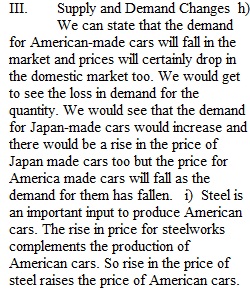


Q ECON 201 HOMEWORK II Summer I 2022 Due May 13th, 2022 Chapters 3 and 4 I. Supply and Demand Changes (be sure to label the axis on all of your graphs) a) Suppose that you do a national survey of Americans, asking them how they feel about American-made cars versus Japanese-made cars. Suppose as well that you discover that Americans’ “taste” for American-made cars has decreased and the taste for Japanese- made cars has increased. Using the demand and supply model, show how this change in taste for American-made cars will impact the market for American-made cars. Give your predictions for the change in the equilibrium price and the equilibrium quantity of American-made cars bought and sold. b) Suppose that you have information indicating that the price of steel (an important input of production in the auto industry) has doubled during the past few months. Show how this economic shock will influence the market for American made cars and give your predictions for equilibrium price and sales change. c) Suppose both (a and b above) of these shocks are occurring simultaneously. Now what would be your prediction for equilibrium price and sales change in the American car market? d) Suppose Congress approves a proposed “temporary worker” program and American firms find out that they are able to hire workers while paying lower wages. This happens because workers become ‘less scarce’. How would this economic shock impact the market for lettuce? e) Scientific reports have shown that iceberg lettuce (much of it grown in California) show high levels of contamination from rocket fuel. California farmers use the Colorado River for irrigation of their fields and the water of the Colorado River is contaminated from production on sites used by several defense contractors. How would this economic shock impact the market for lettuce? (Hint: This is a demand side shift) f) Suppose both shocks (d and e above) occur simultaneously. Now what would be your predictions for equilibrium price and sales change? g) There are four possible ways that demand and supply can simultaneously shift in a market. These ways are listed below. For each case, draw two demand and supply graphs and show the demand change on the first graph and the supply change on the second graph. On each graph, indicate the direction of the change in P* and Q*. Finally, in each case, give your prediction for the overall net impact on P* and Q* for the market when both the demand and the supply change simultaneously. • Simultaneous Increase in Demand and Increase in Supply • Simultaneous Decrease in Demand and Decrease in Supply • Simultaneous Increase in Demand and Decrease in Supply • Simultaneous Decrease in Demand and Increase in Supply ? II. Price Controls (be sure to label the axis on all of your graphs) The table below shows the demand and supply schedules for the low-skilled labor market in the city of Jacksonville. Hourly Wage (dollars) Quantity of Labor Supplied (1,000s) Quantity of Labor Demanded (1,000s) $8.00 10 50 8.50 20 40 9.00 30 30 9.50 40 20 10.00 50 10 10.50 60 0 a. Draw supply and demand curves for the labor market (This graph does not have to be drawn to scale, but make sure to label all curves and axes). b. What is the equilibrium hourly wage (W*) and the equilibrium quantity of labor (Q*)? (5 pts) c. If the current market wage is $10.50, how does the labor market adjust back to the equilibrium? d. If a minimum wage of $8.50 an hour is mandated, what is the quantity of labor demanded? what is the quantity of labor supplied? What is the amount of shortage or surplus in the labor market as a result of the price control? e. If a minimum wage of $9.50 an hour is mandated, what is the quantity of labor demanded? what is the quantity of labor supplied? What is the amount of shortage or surplus in the labor market as a result of the price control? f. Using the supply and demand graph in part (a) above, illustrate the effect of the price control.
View Related Questions